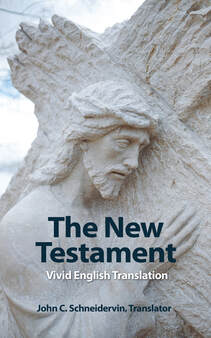A Brief Historical Introduction To The New Testament
Four Centuries of Silence from 400 B.C. to the Coming of John the Baptist
After the prophetic ministry of Malachi and his writing of the Book of Malachi, which completed the Old Testament Scriptures, there was a period of 400 years of silence. During those 400 years God did not speak to his people of Israel through prophets.
The Empires during That Period of 400 Years and Important Events That Occurred
The Persian Empire 538-330 B.C.
The Four Centuries Of Silence Was Brought to an End
The Time Had Fully Come
Information about the New Testament
Its Name Attributed to Tertullian (A.D. 200). See Luke 22:20 and Hebrews 9:15. “Testament” is similar to “covenant”. The Old Testament was called the “Book of the Covenant” (2 Kings 23:2). Jeremiah foretold the Lord would establish a new covenant (Jeremiah 31:31-34). Jesus’ blood established the new covenant of God’s gracious forgiveness.
The Five Types Of Books in the New Testament:
After the prophetic ministry of Malachi and his writing of the Book of Malachi, which completed the Old Testament Scriptures, there was a period of 400 years of silence. During those 400 years God did not speak to his people of Israel through prophets.
The Empires during That Period of 400 Years and Important Events That Occurred
The Persian Empire 538-330 B.C.
- A remnant of the Israelite people was allowed to return to Judah to rebuild Jerusalem and the temple.
- The Koine (common) Greek language spread throughout the Mediterranean World.
- Jews resettled throughout the Mediterranean World.
- Upon the death of Alexander his empire was divided among his four ranking generals. Judah and the Jews came under the rule of the Seleucids in Syria. Antiochus Epiphanes tried to impose Greek ways on the Jews, persecuted the Jews, and desecrated the temple of the Jews, which led to the revolution led by the Maccabees.
- Pompey conquered Palestine.
- The Pax Romana came into being after the defeat of Anthony and Cleopatra in 31 B.C., establishing a Roman peace.
The Four Centuries Of Silence Was Brought to an End
- John the Baptist began his ministry in A.D. 27. He was the Elijah promised by Malachi (Malachi 4:5) and identified by Jesus (Matthew 11:11-14, 17:11-13). John the Baptist pointed to Jesus as the Lamb of God who had come to take away the sin of the world (John 1:29).
The Time Had Fully Come
- After about 4,000 years from the time of creation, and after God had prepared everything for the coming of Jesus, God sent his Son into the world (Galatians 4:4).
- The center of power had been shifted from the East (Assyria, Babylon, Persia) to the West (Greece, Rome).
- The Greek influence of philosophy had diminished to skepticism (John 18:38).
- The Koine (common) Greek language was the international language of commerce, which provided a common language in which the apostles could spread the gospel of Jesus Christ in the world. The Koine Greek became the language of the New Testament Scriptures.
- The Roman Empire had been established by Rome using its legions to expand its sphere of control. Rome then used its legions to keep the Roman peace and to preserve safe passage by roadways and by the sea for travelers. The Roman peace enabled the apostles to travel throughout the Mediterranean World to spread the gospel of Jesus.
- Jews, who had been scattered throughout the Mediterranean World, had established many synagogues. Those synagogues gave the apostles starting places where they often began their mission work of spreading the gospel of Jesus.
- Many Jews had been allowed to return to Judah and Jerusalem, which lay in the land bridge between the two continents of Africa and Asia. It was here that God had Christ Jesus come into the world.
Information about the New Testament
Its Name Attributed to Tertullian (A.D. 200). See Luke 22:20 and Hebrews 9:15. “Testament” is similar to “covenant”. The Old Testament was called the “Book of the Covenant” (2 Kings 23:2). Jeremiah foretold the Lord would establish a new covenant (Jeremiah 31:31-34). Jesus’ blood established the new covenant of God’s gracious forgiveness.
The Five Types Of Books in the New Testament:
|
Biography
Matthew Mark Luke John |
History
Acts |
Pauline Letters
Romans 1 Corinthians 2 Corinthians Galatians Ephesians Philippians Colossians 1 Thessalonians 2 Thessalonians 1 Timothy 2 Timothy Titus Philemon |
General Letters
Hebrews James 1 Peter 2 Peter 1 John 2 John 3 John Jude |
Prophetic
Revelation |
Formation of the New Testament
- As the early church spread out and the apostles began to die, a need arose to have a written record of the life, ministry, and teachings of Jesus.
- As problems erupted within the churches, a need arose to teach doctrines anew and to address those problems.
- The books of the New Testament were written while many other writings were written and circulated, some of which writings claimed apostolic authority. A need arose to distinguish between the true inspired writings of the Lord’s apostles and the mere writings of men.
- The church began to distinguish between what were the genuine writings of Scripture by the apostles and the false writings of men. This led to the present New Testament canon. A canon was a measuring reed, and it became synonymous for a standard of measurement. The term was used for those books that the church accepted as the inspired, inerrant Word of God.
Return to New Testament History page




